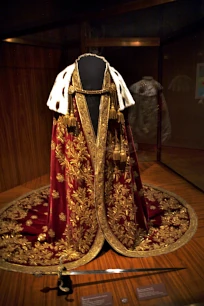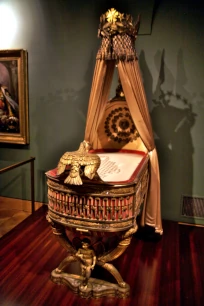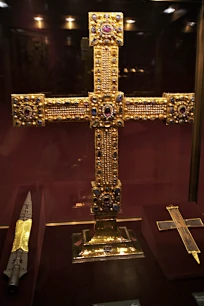The most fascinating of the many museums that are housed in the Hofburg Palace is the Schatzkammer, home to a magnificent collection of crown jewels and relics, acquired by the Habsburg dynasty over a span of almost one thousand years.

The treasures of the Habsburg rulers were initially stored in the sacristy of the imperial chapel. The treasury consisted of precious metals and jewels, as well as important documents and relics that served to underline their power.
The treasury’s collection grew significantly during the sixteenth century, under the reign of Emperor Ferdinand I and later Rudolf II, who moved the treasures to a dedicated wing, known as the Kunsthaus. Since the eighteenth century, the Schatzkammer is located in the Alte Burg, and accessible from the Schweizerhof, the oldest inner court of the Hofburg.


The collection is now displayed in twenty-one rooms, with the first sixteen dedicated to secular treasures such as imperial regalia, while the other five contain ecclesiastic treasures such as reliquaries.
Habsburg Empire
The secular treasures of the Habsburgs are among the most impressive of the museum. On display are some of the most magnificent crown jewels created during the Middle Ages, such as the imperial crown, inlaid with rubies, pearls, diamonds and a large sapphire. The magnificent golden crown was created in Prague by Jan Vermeyen, a renowned goldsmith from Antwerp.
The imperial scepter and orb were created about a decade later. Another showpiece is the gold embroidered cloak with ermine collar that Franz I wore for his coronation as king of Hungary in 1830. There’s also an ornate cradle on display, made by Pierre-Paul Prud’hon for the son of Emperor Napoleon I and his second wife Marie Louise, who was the daughter of Emperor Franz I. After the fall of Napoleon, his son lived in exile in Vienna, where he died from tuberculosis in the Schönbrunn Palace at the age of twenty-one. Also on display is a collection of jewelry from the Habsburgs, which includes the world’s largest cut emerald. Most of the private collection of jewelry were taken out of Austria by Charles I just before the fall of the empire.
Holy Roman Empire
Another highlight of the museum are the crown jewels of the Holy Roman Empire, in particular the octagonal imperial crown, created in 962 for the coronation of Otto I and studded with precious stones. The imperial orb was created in the late twelfth century and the scepter in the fourteenth century.

Other treasures from the Holy Roman Empire include the tenth century saber from Charlemagne, an eleventh-century imperial sword and an early thirteenth-century ceremonial sword of Frederick II.
Burgundian Treasures
The most important Burgundian treasures are the insignia of the Order of the Golden Fleece, a chivalry founded in 1430 in Bruges. They were obtained by the Habsburgs when Maximilian I became Grand Master of the order. On display are mantles and a collar of the Order of the Golden Fleece.

Ecclesial Treasures
The Gheistliche Schatzkammer (Sacred Treasury) contains sacred treasures such as liturgical vestments and objects that were used during religious services. There’s also a large display of reliquaries. Some of the Habsburg monarchs were very devout and collected numerous relics, in particular Emperor Charles IV, who is said to have collected hundreds. Some relics are displayed in the Gheistliche Schatzkammer while others are on display in the galleries of the Holy Roman Empire. You’ll find items such as the Holy Lance, a relic of the Holy Cross, a tooth of St. John the Baptist and a splinter, allegedly from Christ’s crib.
A Unicorn!
Even more bizarre than all those relics are some of the private treasures of the Habsburgs that turned out to be not so special after all. One such items is what was thought to be the horn of a unicorn… it turned out to be a giant tusk of a narwhal. Another item is the Achatschale (Agate bowl), brought from Constantinople in 1204 and long thought to be the Holy Grail.
- Next: Burgtheater
- More Sights & Attractions in Vienna

